![]()
![]()
![]()
Use LEFT and RIGHT arrow keys to navigate between flashcards;
Use UP and DOWN arrow keys to flip the card;
H to show hint;
A reads text to speech;
51 Cards in this Set
- Front
- Back
|
1.1 Why should you study BPM?
|
1. Processes are at the core of every organization 2. Process improvement is highly valued 3. BPM is a key IT-related skill of a Business Analyst 4. There are jobs in BPM (that are difficult to offshore) 5. For many businesses, BPM ranks as a top priority for 2012 6. IT-advisory firm, Gartner, believes BPM is important. |
|
|
1.2 Emergency Exemple of Organisational Process and Organizational Structure
|
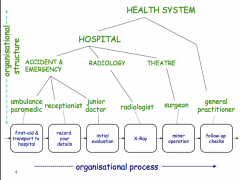
|
|
|
2.1.1 Galbraith's Star Model of Organisational Design 1 - Strategy
|
Company's formula for success. It sets the organization's direction and encompasses the company's vision and mission, as well as its short-and long-term goals. |
|
|
2.1.2 Capabilities
|
The unique integrated combination of skills, processes,human abilities, and technology. |
|
|
2.1.3 Structure
|
|
|
|
2.1.4 Processes |
• How decisions are made • The work flow between roles • The mechanisms for collaboration |
|
|
2.1.4 Rewards |
• How behaviour is shaped by the goals • How we assess progress
|
|
|
2.1.5 People
|
• What skills are needed • How we best develop our talent |
|
|
2.1.6 The key of Organisational Design
|
|
|
|
2.2.1 Function Structure vs. Product Structure
|
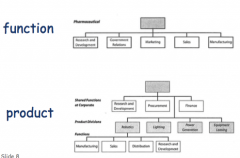
|
|
|
2.2.2 Which structure is more likely to favourindividual incentive rewards: function or product?
|
In product structure, they develop a strong team identity around the productsthey produce and the markets they serve. So measures and rewards are typically closely linked to business unit success, instead of individual performance. In functional structure, the depth of expertise and specialisation is needed so the individual incentive rewards are more likely to be favoured. |
|
|
3.1 Waves of process improvement
|
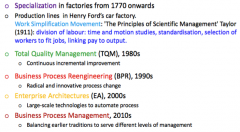
SWTBEB |
|
|
3.2 BPM is the convergence of three approaches to process improvement |
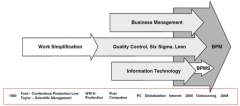
|
|
|
3.3 PROBLEMS with organisational structures that are based on functions, hierarchical command, and 'management by objectives' - which could be solved by TQM |
* functional groups work for themselves, and sometimes against the overall process * quotas and targets lead to game playing * hierarchical control takes away workers' desire to improve and maintain quality * managers become distant from the realities of work process |
|
|
3.4 Six Sigma |
|
|
|
3.5 Critical-to-Quality |
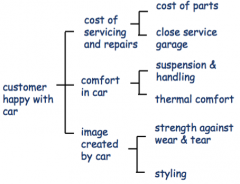
|
|
|
4.1 The 7 types of waste |
Lean - focus on efficiency; centres around the identification and reduction of WORMPIT WORMPIT 1. Waiting - gaps between process steps 2. Over production - production more than the customers can consume 3. Rework - damage to the process through the need to rework defective products (or services) 4. Motion - inflict wear and tear on resources (eg. separating people who need to work together) 5. (Over) Processing - work which adds no value for the customer (eg. a too long report) 6. Inventory - supplied goods that lie idle 7. Transportation - movement of goods (or information) risks damage or loss (distortion of information) |
|
|
4.2 Business Process Reengineering (BPR)
|
|
|
|
4.3 An example for BPR 1
|
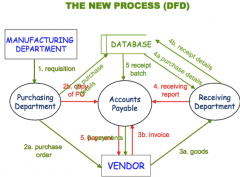
|
|
|
4.3 An example for BPR 2 |
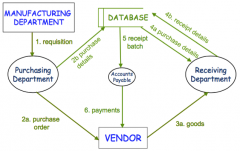
|
|
|
4.3 TQM vs. BPR in the devil's quadrangle
|

|
|
|
7.1 Enterprise Systems Definition |
|
|
|
7.2 Example Enterprise Systems include
|
– Enterprise Resource Planning (ERP) – Customer Relationship Management (CRM) – Supply Chain Management (SCM) – Data Warehousing Systems (DWs) – Software platforms on which these applications are built (e.g., SAP’sNetWeaver) |
|
|
7.3 SAP's Business Suite, 2008 |
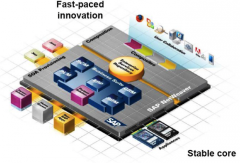
|
|
|
7.4 Achieving Fit
|
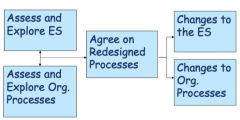
|
|
|
7.5 Configuration and Customization
|
|
|
|
7.5 In what ways is an Enterprise Systemsflexible to suit the needs of different organisations? |
• Industry-specific process maps • Package selection • Configuration • Customisation • Exchange of data through SOA (service-oriented architecture) |
|
|
7.7 Customer Relationship Management
|
• Customer relationship management (CRM) software is“packaged software that supports an organization’s customer strategy and customer-focused business processes.”
• Benefits: – Improved Customer-facing Processes – Improved Management Decisions – Improved Customer Service – Increased Business Growth and Revenue
CRM systems provide ICT support for hundreds of routine customer-facing processes, including customer analytics. |
|
|
7.7 Customer Relationship Management
|
• Customer relationship management (CRM) software is“packaged software that supports an organization’scustomer strategy and customer-focused businessprocesses.”
• Benefits: – Improved Customer-facing Processes – Improved Management Decisions – Improved Customer Service – Increased Business Growth and Revenue
CRM systems provide ICT support forhundreds of routine customer-facingprocesses, including customer analytics. |
|
|
7.8 An example of CRM
|
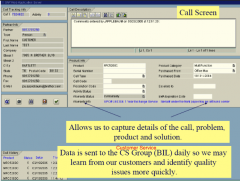
|
|
|
8.1 Data Warehouse and Business Intelligence work together
|
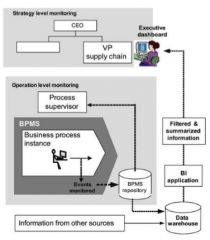
|
|
|
8.2 Data Warehouse Case 2
|
Volvo+Teradata Volvo Car Corporation drives product design, quality, cost reduction, and customer satisfaction through data-driven decision-making. |
|
|
9.1 Conclusion about markets
|
All else being equal, markets appear to provide the optimal means of allocation of resources. |
|
|
9.2 Comparing costs: firms vs. markets
|
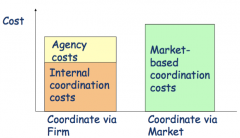
|
|
|
9.3 Fraud & Human Error
|
– Human Error (internal coordination cost)
|
|
|
9.4 Hidden process 1
|
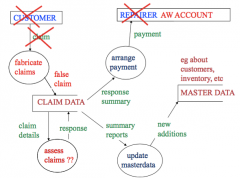
|
|
|
9.4 Hidden process 2 |
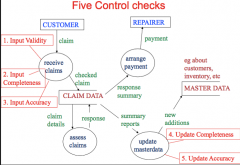
|
|
|
9.5 Failure to segregate duties
|
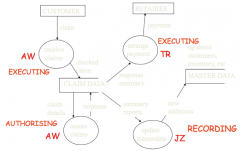
|
|
|
9.6 How to segregate duties
|

|
|
|
10.1 Business Process Architecture |
|
|
|
10.2 Administration Function vs. Core Strategy (Magpie)
|
|
|
|
A.1What is an organisational/business process |
A collection of related events, activities and decisions, that involve a number of actors and resources, and that collectively lead to an outcome that is of value to an organisation or its customers. |
|
|
A.2) Important characteristics of organisational process |
|
|
|
B.1) Explain why ‘process thinking’ is a significant way to understand organisation design. |
|
|
|
B.2) Galbraith’s five basic organisational structures
|

|
|
|
D.1) The purpose of an IGOE diagram |
|
|
|
D.1) The purpose of an IGOE diagram |
|
|
|
D.2) How might people in organisations find IGOE diagrams useful? |
The bigger purpose of an IGOE diagram
|
|
|
E) For BPMN |
|
|
|
F) For Redesign principles |
|
|
|
G) For Physical DFD |
circle for internal, rectangle for externals, line for information, double line for data storage
|

